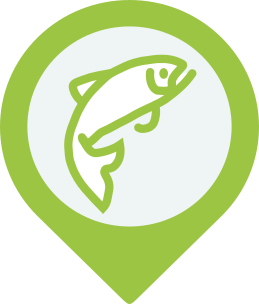Atlantic salmons study Areas (IAS) by session - Sélune Observatory
The opening of the dams will have a significant impact on the Atlantic salmon populations swimming up the Sélune River and its tributaries. Restoring the river's ecological continuity will modify population flows, allowing atlantic salmons to migrate further upstream and downstream of the dams. The atlantic salmons population is monitored at a network of stations covering the entire Sélune basin, using an abundance index carried out every 2 years.
Field campaigns comply with the fishing protocol developed by INRAE and OFB. The aim of this method is to estimate the abundance of juvenile Atlantic salmon (Salmo salar) at a station (or sector). This protocol targets juveniles of the year (aged 0+) whose abundance reflects the renewal of generations within the population (or recruitment) and survival after the embryonic development phases under gravel and the first months of life in the open environment. Field campaigns are carried out by INRAE and the Fédération de la Manche et d'Ille-et-Vilaine pour la Pêche et la Protection du Milieu Aquatique (FDAPPMA35).
This layer shows the locations of these study sectors by year of study: 2012, 2013, 2014, 2015, 2018, 2019, 2020, 2021, 2022, 2023 and 2024.
Simple
- Date (Publication)
- 2025-09-29T00:00:00
- Edition
-
Mise à jour 2024
- Edition date
- 2025-09-29
- Identifier
- fr-18007003900276-umrsas-selune-sctr_IAS_selune
- Purpose
-
The purpose of this data is to locate where salmons catches were made as part of the Sélune observatory.
- Status
- Completed
https://programme-selune.com/fr/
- Maintenance and update frequency
- As needed
- Theme
-
-
Données ouvertes
-
- Theme
-
-
Limite
-
- Use limitation
-
Unrestricted use subject to the following compulsory wording on all distribution documents: "Source: INRAE - U3E".
- Use limitation
-
Open licence : https://www.etalab.gouv.fr/licence-ouverte-open-licence
- Access constraints
- Other restrictions
- Use constraints
- License
- Other constraints
-
No public access restriction
- Spatial representation type
- Vector
- Denominator
- 25000
- Metadata language
-
fre
- Topic category
-
- Environment
))
- Begin date
- 2012-09-02
- End date
- 2027-12-31
- Reference system identifier
- RGF93 / Lambert-93 (EPSG:2154)
- Geometric object type
- Point
Distributor
- Name
-
ESRI Shapefile
- Version
-
1.0
- OnLine resource
-
v_bioc_ias_sctr_ias_sessions
(
OGC:WMS
)
Secteurs d'étude des saumons atlantiques (IAS) par session - Observatoire Sélune
- OnLine resource
-
Download "Brown trout Study Areas (IAT) by session - Sélune Observatory" in shapefile
(
WWW:DOWNLOAD-1.0-http--download
)
Download "Brown trout Study Areas (IAT) by session - Sélune Observatory" in shapefile
- OnLine resource
- Observatoire Sélune ( WWW:LINK-1.0-http--link )
- OnLine resource
- Rapport d'activités 2024 de l'Observatoire des biocénoses aquatiques de la Sélune ( WWW:LINK-1.0-http--link )
- OnLine resource
- Dispersion et (re)colonisation du cours de la Sélune et de ses affluents ( WWW:LINK-1.0-http--link )
- OnLine resource
- Rapport d'activité Observatoire des biocénoses aquatiques de la Sélune 2019-2021 ( WWW:LINK-1.0-http--link )
- OnLine resource
- Observatoire des biocénoses aquatiques de la Sélune - rapport d'activités 2022 ( WWW:LINK-1.0-http--link )
- OnLine resource
- Observatoire des biocénoses aquatiques de la Sélune - rapport d’activités 2023 ( WWW:LINK-1.0-http--link )
- OnLine resource
-
Télécharger "Secteurs d'étude des saumons atlantiques (IAS) par session - Observatoire Sélune" au format CSV
(
WWW:DOWNLOAD-1.0-http--download
)
Télécharger "Secteurs d'étude des saumons atlantiques (IAS) par session - Observatoire Sélune" au format CSV
- OnLine resource
- Indice d'abondance saumon (IAS) ( WWW:LINK-1.0-http--link )
- Hierarchy level
- Dataset
Conformance result
- Date (Publication)
- 2013-12-10
- Explanation
-
Non Evalué
- Pass
- No
- Statement
-
Monitoring of amphihaline fish populations in the Sélune is carried out on the main river and its tributaries, both upstream and downstream of the old dams. This allows us to understand the dynamics of these populations before, during, and after the dams are demolished. Brown trout, Atlantic salmon, European eel, and lampreys (marine, river, and Planer) are species of high conservation importance. The populations are monitored using various inventory protocols (electrofishing, trapping, DNAe) supplemented by sampling aimed at better characterizing the populations (genetics, scalimetry).
The objectives of this monitoring are:
- to estimate the level of recruitment in 0+ and 1+, the evolution of cohorts, and the abundance and density of trout (Salmo trutta);
- to monitor biometrics (measurements, scale sampling, and scalimetry) at reference stations;
- to study intra- and inter-population genetic structure and the impact of migratory individuals and the movement of sedentary trout downstream and upstream of dams on the entire population (fin sampling).
Sampling has been annual since 2022 and biannual before that.
The protocol implemented is the “Gaétan Pottier, Frédéric Marchand, Sabrina Servant, Etienne Prévost. Indice d’abondance saumon
(IAS). Collection Guides et Protocoles. La pêche scientifique à l’électricité dans les milieux aquatiques
continentaux, INRAE; OFB, 2022. ffhal-03757386".
The stations (also called study areas) were located using a hiking GPS (expected planimetric accuracy <= 20 m).
- Feature catalogue citation
- File identifier
- 8cfe4621-91cf-45c4-b5c1-63903b88c21d XML
- Metadata language
-
fre
- Character set
- UTF8
- Parent identifier
-
Programme scientifique Sélune
32b2d23e-0f67-46fb-ad72-110514f1c8ee
- Hierarchy level
- Dataset
- Date stamp
- 2025-09-29T15:26:04
- Metadata standard name
-
ISO 19115
- Metadata standard version
-
1.0
http://geowww.agrocampus-ouest.fr
Overviews

Spatial extent
))
Provided by

 OSURIS
OSURIS